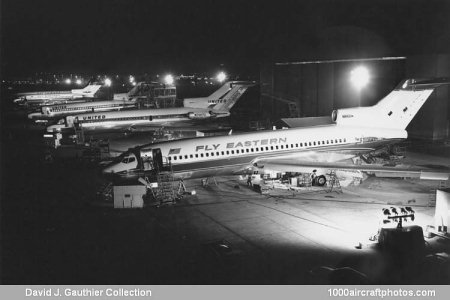All 727s were equipped with hydraulically operated self-contained aft loading stairs and additional stairs could be installed forward of the cabin on the port side of the fuselage. Exceptional low-speed and short-field performance was obtained by use of new triple-slotted trailing edge flaps, retractable leading edge slats outboard of the taper break, and Krueger flaps inboard on the clean 32°-sweep wing.
Boeing did not originate the most noticeable feature of the 727-the aft-mounted engine installation. Jet pods on the side of the fuselage were tried on the German Junkers Ju-287 late in WW-II but were first used in regular production on the French Sud-Aviation Caravelle of 1955, which originated the aft location. This arrangement had three major advantages-increased ground clearance for the engine, reduced noise level in the cabin during take off, and reduced trim problems with one engine inoperative. Several other manufacturers followed the French in adopting this arrangement.
The use of a third engine installed in the aft end of the fuselage originated with the Martin XB-51 of 1948. Since it was desirable from the economy and reliability standpoints to use three engines on the 727, Boeing chose to cluster all three near the tail, two in pods and one under the vertical tail on the pattern developed for the British de Havilland D.H.121 Trident, a directly competitive aircraft. All three 14,000 lb (6,350 kg) st Pratt and Whitney
JT8D-1 turbofan engines, developed specifically for the 727, were fitted with thrust reversers but did not use sound suppressors.
Special design features mix bypass air with the exhaust to reduce exit velocities and effectively reduce noise. The quiet operation of the 727 compared to larger jets enabled it to overcome the jet ban at La Guardia and became the first jet to operate from that close-in terminal. To eliminate the need for starting equipment at small airports, a gas turbine in the right wheel well of the 727 served as an auxiliary power unit for starting, air conditioning, and other power requirements while the aircraft was on the ground.
First flight of the 727 was on February 9, 1963, and TC A3WE was issued December 24, 1963. Launch customers were United Air Lines, which bought 95 727-22s, and Eastern Air Lines, which bought 50 727-25s. The latter differed from other 727s in having self-contained hydraulic airstairs fitted to the forward entry door.
Span: 108 ft 0 in (7.20 m)
Length: 133 ft 2 in (6.20 m)
Height: 34 ft 0 in (2.33 m)
Wing area: 1,650 sq.ft (14 sq.m)
Weight empty: 80,602 lb (360 kg)
Loaded weight: 160,000 lb (572 kg)
Max speed: 632 mph (145 kmh)
Cruise speed: 596 mph (120 kmh)
Climb: 2,940 ft (1,000 m)/min
Service ceiling: 36,100 ft (11,003 m)
Range: 3,430 mls (1,300 km)
N7007U was the ninth 727 produced and was first flown on August 15, 1963. The aircraft was delivered to United Air Lines on December 18, 1963, and served with the airline for nearly 30 years. It was sold to Aero Controls at Shelton, Washington, in February 1993, and by October 1994 it had been broken up.
N727RL was the eleventh 727 produced and first flew September 9, 1963, and was the first 727 delivered to an airline on November 15, 1963. From December 1981 to March 1982, it was leased to Aeronica (Aerolineas Nicaraguenses, Nicaragua Airlines). In December 1982 it was registered to the Government of Liberia as EL-GOL, and returned to the USA Registry in November 1987, registered to Regional Leasing. The aircraft was broken up by Charlotte Aircraft Corp., Charlotte, North Carolina, in February 1989.
